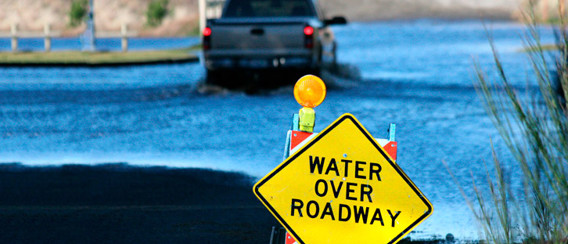Water World: What you may Not Know about Submerged Fibers
So, you have water in your manhole. OK, we know how water can hurt twisted copper pair, but what about fiber-optic splices and connectors? What then, when the flood comes along?
If properly spliced fiber is submerged underwater, will there be larger loss, more reflectance? And in the case of connectors: will the OTDR detect a fiber end due to water? Is there any way to determine whether a manhole is flooded using an OTDR signature?
Of course, most splices and connectors are housed in sealed enclosures, keeping water out even if the manhole is flooded. But let’s say that they aren’t, and water seeps in. The connection is a permanent fusion splice, so water can’t get into it. Even if the glass of the fibers is exposed by removing the coatings to make the splice, most modern fibers are now very resistant to hydrogen ingress. If you were to wrap the fiber with a water-swellable tape (something that imparts a stress on the fiber in the presence of water), you would be able to see this on the OTDR. This method is a common water-sensing technique.
As for connectors, it depends. If the connection is tight, some moisture may get in between the endfaces, but shouldn’t cause a bigger reflection. The loss would remain pretty much the same as well. However, if the connection is not tight, contaminants in the water may be able to seep in between the endfaces. This would lead to a loss, and a change in the reflectance.
Of course, the biggest issue would come from areas in which the water could freeze at lower temperatures. The major water-induced issue on splices/enclosures is mechanical, and brought about by freeze/thaw cycles, thus presenting a longer-term degradation issue. This icing/thawing cycle can cause macro/microbends, in turn leading to embrittlement of the fiber. Well manufactured fiber uses a nonporous buffer coating to minimize the presence of water molecules.
Another consideration is bonding and grounding. Corrugated armor is coated steel offering extra mechanical and rodent protection, but also implies the need to ground and bond. Corrosion of the armor often leads to failed grounding, which can be a life safety issue, not to mention a path for lightening or transient voltage to escape. While unlikely, this is all the same something to be aware of. A poorly bonded metallic element will often have an electrical current induced on it. When currents are induced, impure water (containing low levels of salts) will be hydrolyzed, meaning that the oxygen and hydrogen are split apart and released as gases. And, gaseous hydrogen is "soluble" in a large number materials due to the very small atomic size (one proton and one electron). If the fiber is exposed to pure hydrogen gas for long periods of time, it will eventually absorb the hydrogen and induce a loss near 1382.3 nm, which, if severe enough, can in turn impact other wavelengths (this wavelength is rightfully called “the water peak”). For example, 1410 nm is near enough to be impacted first. Later, if the absorption is allowed to continue, it can eventually impact shorter-wavelength C-band channels, i.e., the wavelengths used in CWDM and PON topologies.
For this reason, long-term fiber degradation is just one of the many reasons why you should consider a remote fiber test system (RFTS).
For more information about RFTS, visit our Fiber Network Monitoring and Management webpage.




